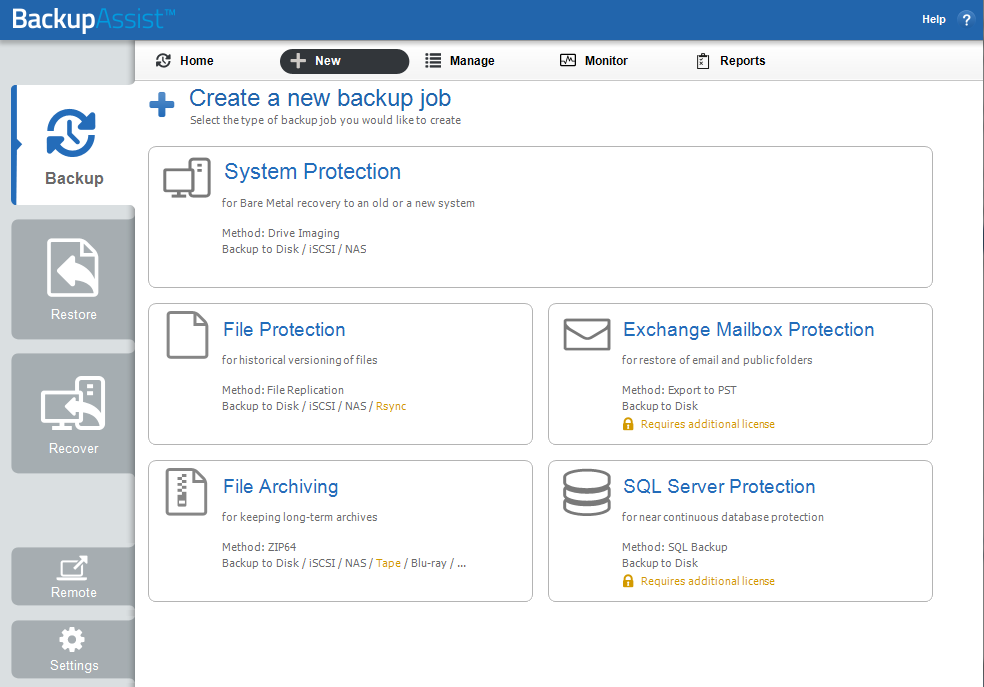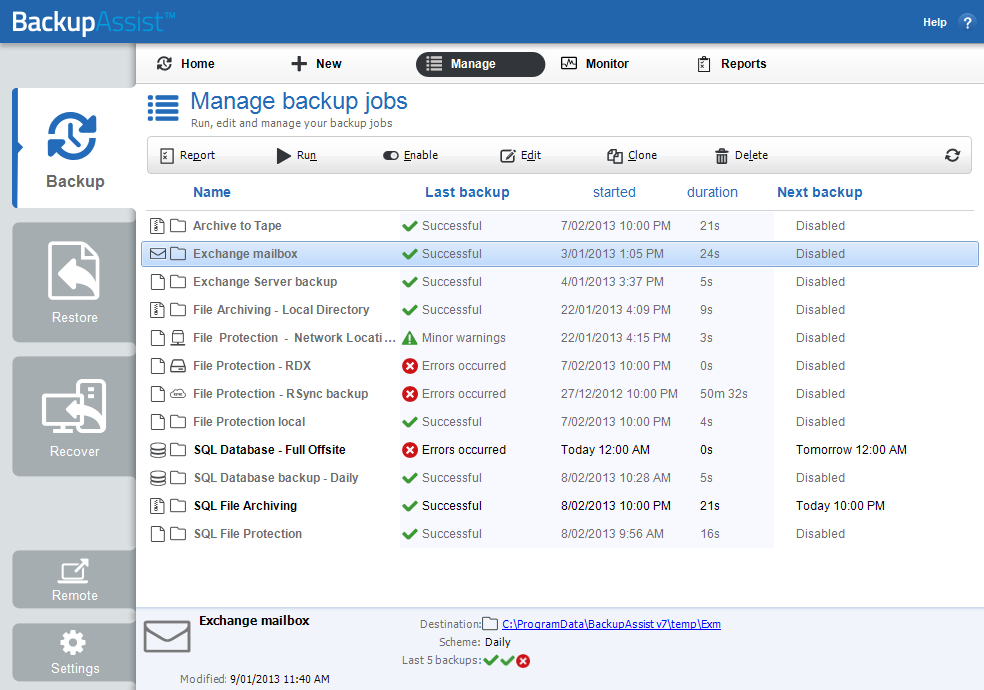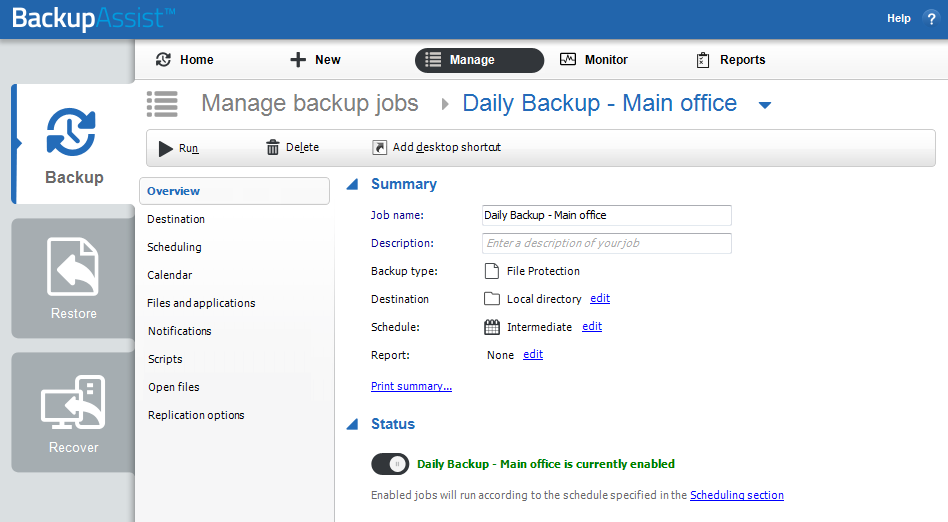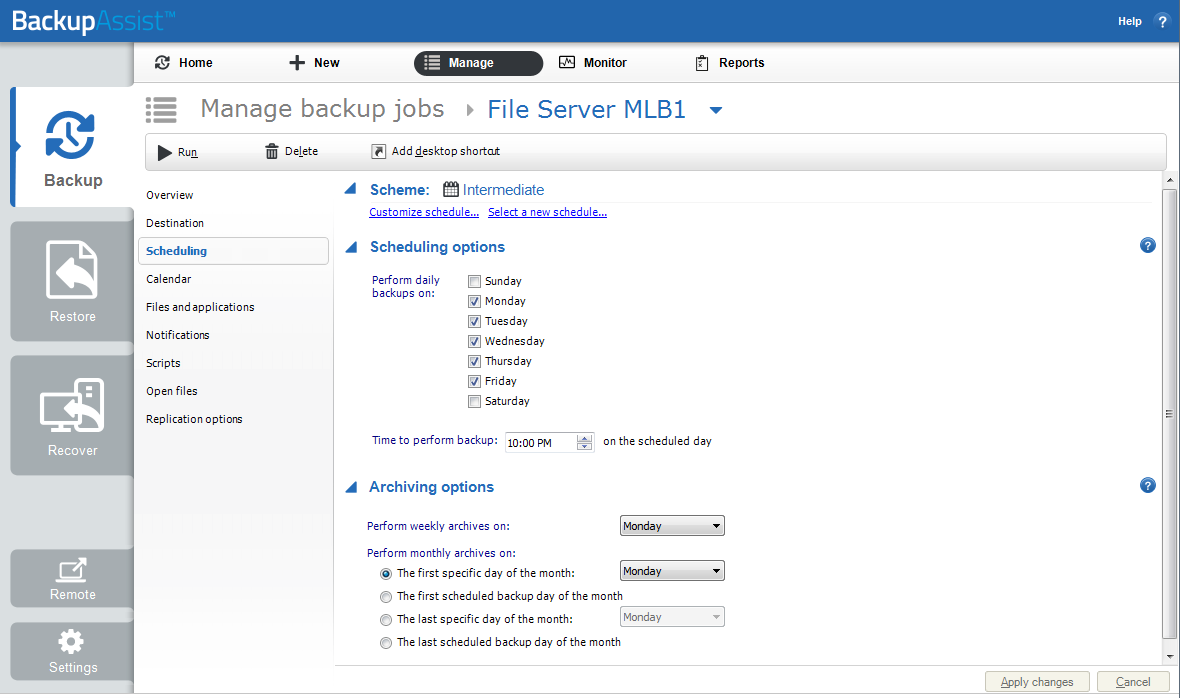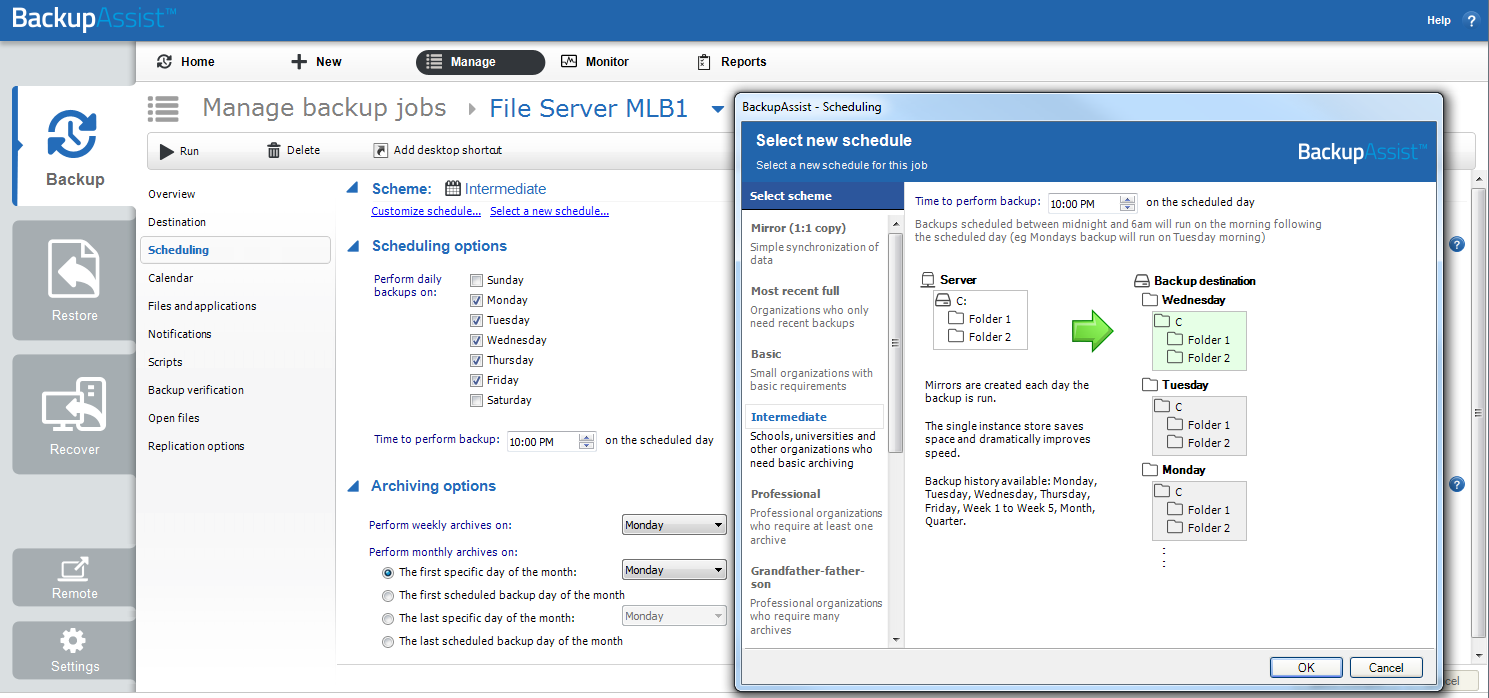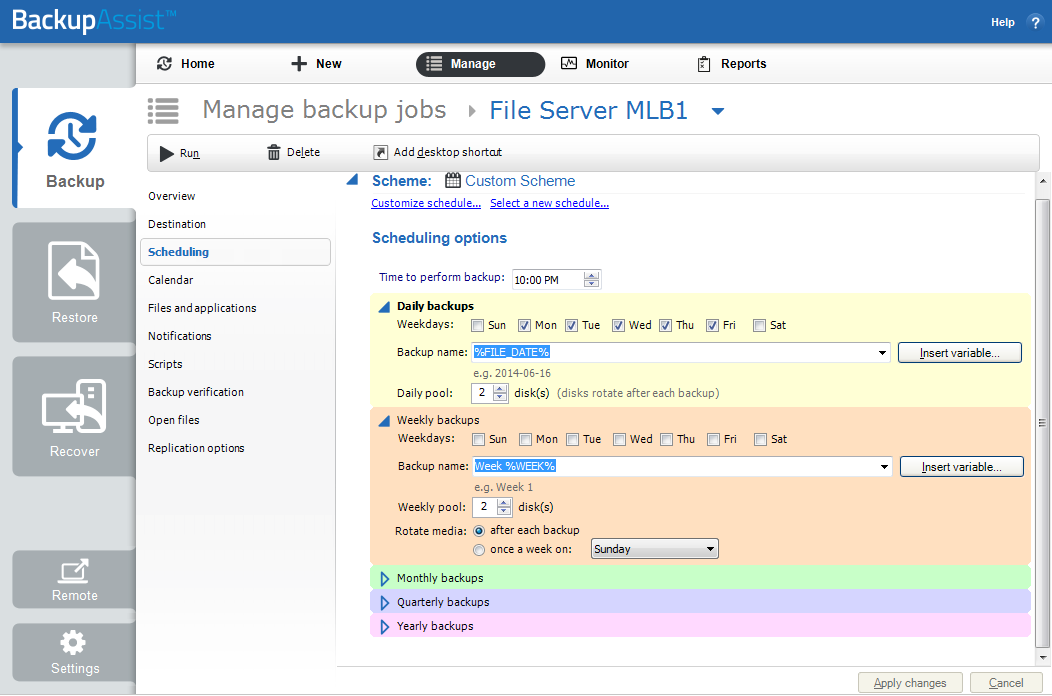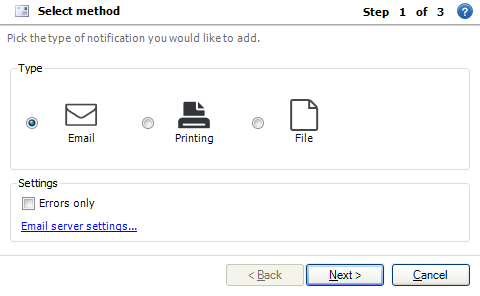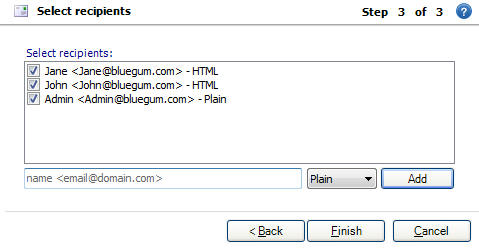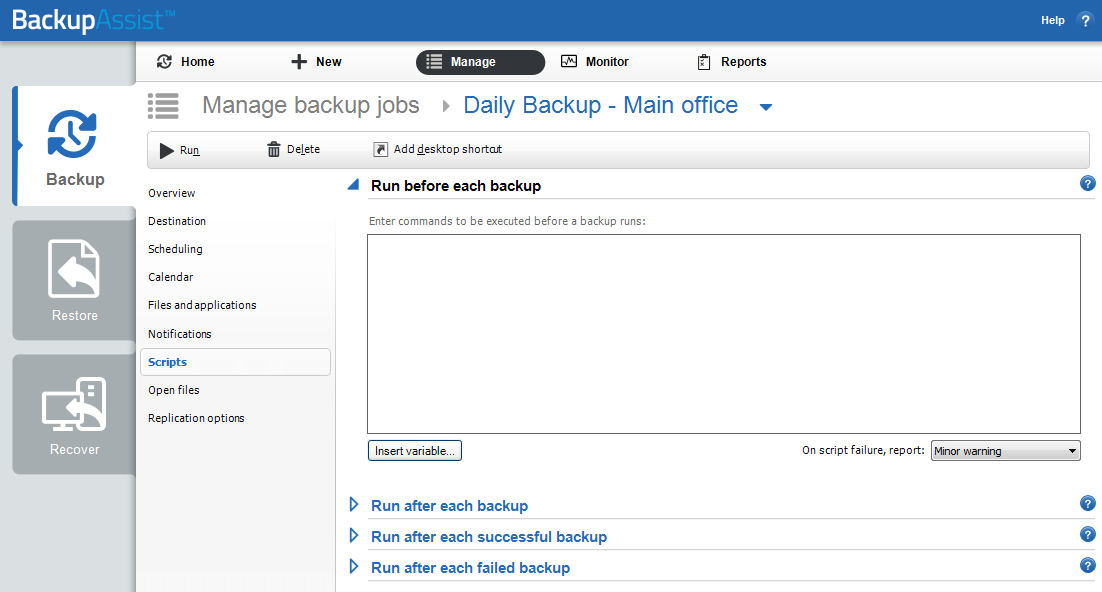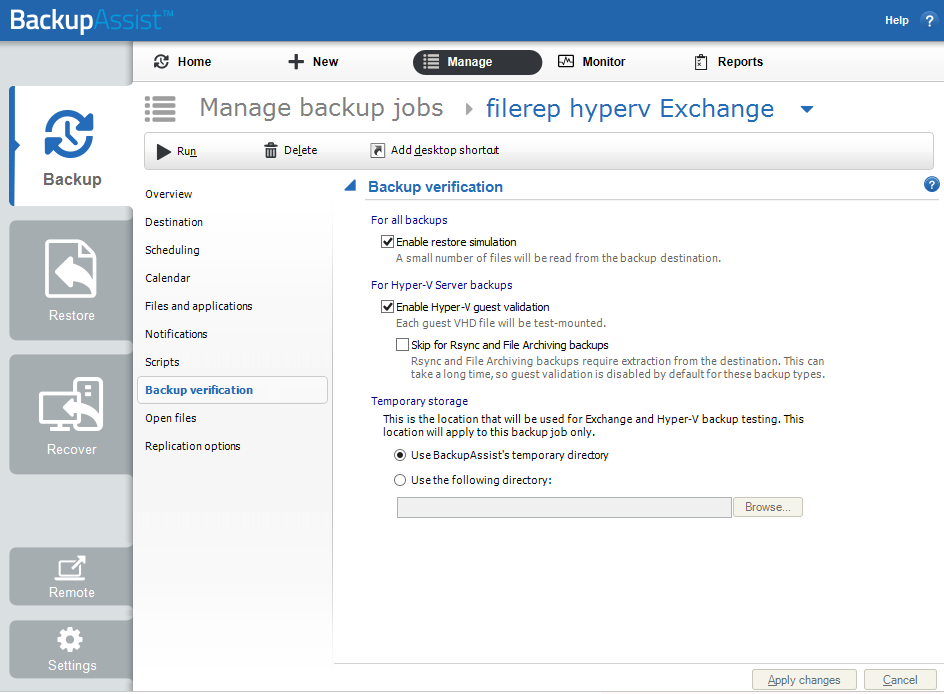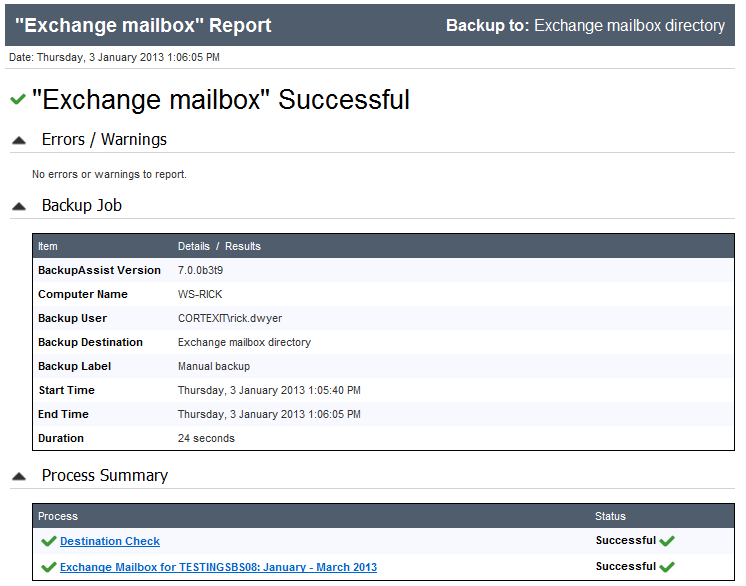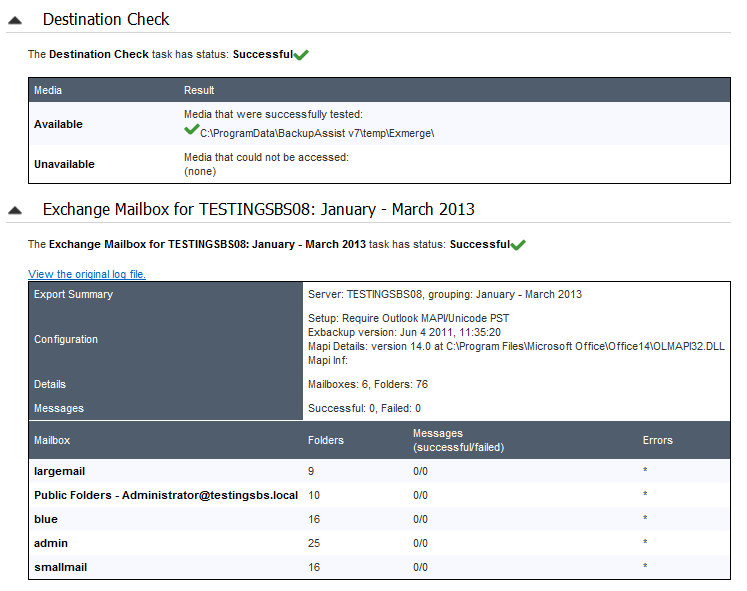 The Backup Tab
The Backup Tab
The Backup tab provides access to a set of powerful backup tools, which are used to protect both data and applications, including Exchange, SQL, SharePoint, Active Directory and Hyper-V environments.
The Backup tab has four menu items used to create, manage, monitor and report on backups.
The New option is used to access the five types of backup jobs that can be run. These backup jobs are documented in their own whitepapers and a summary of each is provided below. The Manage, Monitor and Reports options are documented in detail in this whitepaper.
Online User Guide
Create a New Backup
The New menu will open the Create A New Backup screen. There are 5 types of backups to choose from, and a description of each type is provided below. All of these backup types are administered using the Manage, Monitor and Reports menus.
BackupAssist is VSS-aware, so File Protection, File Archiving and System Protection backups can detect and backup Volume Snapshot Service (VSS) applications such as Exchange, SQL and SharePoint.
-
System Protection
This feature creates an image backup that can be used to restore files and applications. Depending on the data selection made, it can also be used to perform a bare-metal recovery, when used with a bootable media created using RecoverAssist. System Protection backups apply to installations of BackupAssist on Windows 2008 or later machines. -
File Protection
This feature backs up data using file replication and includes support for Rsync, a technology that can back up data to a host across the internet. Rsync requires the BackupAssist for Rsync Add-on. -
File Archiving
This feature compresses data as it is backed up and saves it as a ZIP file. This saves space and allows for the use of encryption and password protection on the archive file. The feature includes the ability to back up to tape media, which requires an add-on license. -
Exchange Mailbox Protection
Exchange Mailbox Protection (Exchange Mailbox Add-on) is fully supported but superseded by Exchange Granular Restore (licensed as the Exchange Granular Add-on). Exchange Granular Restore uses System Protection, File Protection and File Archiving backups to restore mail items. -
SQL Server Protection
This feature backs up SQL Server databases. These backups can be used to restore individual databases to a specific point in time, or an entire SQL server (including the Master Database). SQL Server Protection requires the BackupAssist SQL Add-on.
Manage Backup Jobs
The Manage menu is used to run and administer your backups. The options include configurations that are not available during the creation of the backup job.
When the Manage menu is selected, a list of all backup jobs will be displayed, along with the results of the last backup, when the backup started, its duration and if the backup job is currently active or disabled.
The Manage menu can be used to action the selected backup job, as follows:
- Report will open the most recent backup report for the selected backup job.
- Run will start the backup job. You will be prompted to Rerun a past backup or to Run a future backup now. If you select a future backup, you will be asked to provide the date. Once the backup has started, the screen will change to the Monitor view.
- Enable / disable will change the active status of the backup job. This option can be used to disable a backup job so it will not run, or to enable a job so it will run as scheduled.
- Edit is used to change the backup job's configurations. The selections made during the creation of the backup job can be changed here.
- Clone will create a copy of the backup job, and provide a field to enter a new name.
- Delete will delete the backup job from BackupAssist.
Using the Edit menu
The Edit option gives you access to the backup configurations that were set during the creation of the backup job. It also gives access to additional configurations that were not available during the creation of the backup job.
- Select the BackupAssist Backup tab.
- Select Manage from the top menu.
- Select the backup job, and click Edit. A list of configuration types will be displayed on the left pane.
- Select the required configuration option, and the details of that selection will be displayed.
Some configuration options are common to all backup jobs. Some configuration options are unique to the backup type (e.g. SQL Server Protection), and explained under the Manage section of each backup type's whitepaper.
Below is a description of each standard Edit screen:
Overview
This screen displays a summary of the backup job's settings, and the status of the job.
Destination
This screen displays the destination configurations that were defined during the destination stage of the backup job's creation. For SQL and Exchange Servers, it can be used to configure how the data is saved. For Rsync, it can be used to change the connection settings.
Calendar
This screen gives a month-by-month view of your current schedule, and it can be used to verify that the schedule is configured correctly. Different icons will appear on the calendar’s ‘backup days’ to represent different configurations and settings. Select the Key button for a guide to the symbols used..
Scheduling
This option is used to modify your backup schedule. A backup schedule determines when your backup jobs run and whether the backup is a daily or an archive backup. Combinations of daily and archive backups provide the most flexible and robust data protection.
Archive backups (not to be confused with the File Archiving backup type) are run periodically (e.g. weekly, monthly) and retained for long periods. They provide a secure, historical backup and the ability to restore early versions of data a long time after the backup was made.
Daily backups are run through the week (e.g. Monday to Friday) and provide backups that can be used to restore recent data. They are often overwritten during each media rotation.
If you have scheduled jobs overlapping, they will be placed in a queue and run one at a time.
Backups run after midnight are usually for data from the previous day, to be part of the previous day's backup. To ensure the correct backup applies to the correct day, BackupAssist treats a day as being 6.00am to 5.59am (not 12.00am to 11.59pm). E.g. 2.30am on Tuesday is considered Monday.
BackupAssist provides a selection of schemes to select from during the creation of your backup job. These schemes provide popular combinations of daily and archive backups that can be customized using the Scheduling screen. This screen contains Scheduling options and Archiving options to modify your existing scheme, and two pop-up windows: Select new a schedule and Customize schedule.
Scheduling options
This option allows you to set the time and the days of the week that your backups take place. Your selections will apply to both daily and archive backups (which run in place of daily backups).
Archiving options
The selection will appear if your current scheme includes archive backups. There will be runtime options for each type of archive backup in your scheme (e.g. weekly, monthly). When you select the day you wish your archive backup job to run, it will run in place of the daily backup for that day (weekly runs in place of daily, monthly runs in place of a weekly etc.). The day selected must also be ticked under Scheduling options.
Customize schedule
This window can be used to modify each scheduled backup. The customizations available will depend on the backup type (File Archiving, System Protection etc.).
To customize a schedule:
a. Select Customize schedule to open the customization window.
b. Make your modifications. E.g. rename a label, change the backup Method, set a media to eject.
c. Once you have customized your schedule, click OK and then click Apply changes.
d. Select Calendar from the left menu to verify that your schedule is configured correctly.
- For File Protection backups, the Method will be fixed to automatic because it is managed by BackupAssist due to the incremental imaging technology used.
- For File Archiving backups, you can change the Method used (e.g. full, differential & incremental).
- For File Protection backups, the Method can only be set to Automatic because Single Instance Store (SIS) is used. SIS can provide the benefits of an incremental backup in a full backup format.
Select a new schedule
This will display the list of pre-configured backup schemes you chose from during the creation of your backup. You can select a different scheme using this option. Each scheme provides a pre-configured rotation of daily and archive backups. You can also create a Custom scheme, as explained below.
Select a new schedule - Custom scheme
The list of pre-configured schedules available includes an item called Custom scheme. This option allows you to create a customized daily, weekly, monthly, quarterly and yearly backup rotation. You can see how your Custom schedule will look by selecting the Calendar view.
You can select the Custom scheme option when you create a new backup job, or by using the Select a new schedule option from the Manage backup jobs menu.
- For daily backups, you can select the days the backups are to run on and specify the backup media’s Daily pool. For example, select a pool of 4 media and the daily backups will use those media in successive backups, with the 5th backup re-using the 1st media as the pool is rotated.
- For weekly backups, you can select a weekly archive backup. This overrides the scheduled daily backup and uses a Weekly pool of media, which is rotated for the weekly backups.
- For monthly backups, you can specify the day of the month that the monthly backups are run on. This backup overrides the daily and weekly backups, and uses its own pool of rotated media. Monthly includes many additional options such as the days of the month and months of the year.
- Quarterly backups and Yearly backups follow the same format.
The customizations possible with this scheduling option include:
- The ability to configure layered archive backups, with individual planning options.
- The option to modify the Backup name using variables.
- A flexible media pool, based on the media type selected in the Set up destination screen.
For more information on each backup type, see the respective backup's whitepaper.
Notifications
There are two types of notifications that can be configured for a backup job:
Report notifications
Once a backup has finished, BackupAssist can inform you of the result. You can receive reports for all backups that have completed or only for backups that have failed. Report notifications can be emails, printed reports or saved files.
Maintenance notifications
Some devices need regular maintenance, like tape cleaning and drive defragmentation. Maintenance notifications can remind you to perform these tasks. Maintenance notifications can only be sent as emails.
Before emails can be used for notifications, some configurations need to be made using the BackupAssist Settings tab. There are two items on this tab that apply to email notifications:
Email server settings
To send emails, BackupAssist needs an SMTP server. Use this menu item to enter the details of the SMTP mail server to be used for the email notifications. For more information about Email server settings, see the Backup Settings whitepaper.
Email address list
This option is used to define and store email addresses. This list will be used to populate the recipient list when configuring an email notification. Email addresses can also be added using the notification configuration wizard, and these addresses are automatically added to the Email address list.
Creating a notification
- Select Notifications, from the left pane.
- Click Add notification for either: Report notifications, which will display the Email, Printing and File notification options.Maintenance notifications, which will display the Email notification option.
- Select Email, Printing or File for the notification type.
- Configure the notification
- Select Email, and click Next.
- Create a subject line for the report. You can use custom variables to have a dynamic subject line, such as the job name, the status of the job and the date. The window will present the format, %JOB_NAME% : %STATUS%. Custom variables can be selected from the list. Click next.
- Specify the recipients for the backup report.
- You can select email recipients for this backup report, using the list provided. This list is taken from the Email address list, option in the BackupAssist Settings tab. The Select recipients window can also be used to add new email addresses.
- Set your file name. You can use custom variables to have a dynamic subject line, such as the job name, the status of the job and the date.
- Specify the location for the file to be saved to. You can also specify the format the file is saved in: HTML or Text.
- Click Finish, once the notification type has been configured.
The instructions below are for the configuration of each notification type:
Email: BackupAssist can use your email server to send notifications to any number of recipients. The SMTP server to be used must be entered into the BackupAssist setting tab item, Email server settings.
Printing: Reports can be sent to a printer to provide you with a hardcopy of the backup result. The printer must be set up in Windows under Control Panel > Printers & Faxes.
Be sure the Backup User Identity (BUI) has the printer defined and accessible. When defining a job under another user, a printer may show up but not when the job is executed under the BUI, unless it is defined.
Select the printer(s) you want to print to.
File: BackupAssist can export the report as a file. This can be useful for servers that may not have email or printer access. You can export the file to a directory for later access or for the purpose of archiving.
Scripts
Most users should be able to use BackupAssist without adding custom scripts. The software was designed to include all the options needed to set up a best-practice backup strategy. Before adding custom scripts, please check the options in the console and the help files. It could be the case that the function you require is already available elsewhere in the program. Where possible, you should use inbuilt options rather than custom scripts. If you think your requirement is common enough that it should be in the program, please send us an email at support@backupassist.com
Some users will have requirements specific to their backup strategy. For those users we have provided the ability to add custom scripts to BackupAssist. Custom scripts can be used for a number of purposes: to copy or compress backup files, to integrate with command line programs, to restart services, authenticate to remote machines and deleting files from a directory
There are four separate sections for adding scripts to BackupAssist:
- Before each backup - This script runs before any other step of the backup. You can add scripts here for authenticating to network resources, setting up backup folders or suspending programs that could interfere with the backup, such as anti-virus applications.
- After each backup - This script runs after all the other steps in the backup process have been completed. You can add scripts here to disconnect from network resources, restart any programs that were previously suspended, or to perform any number of post-backup operations.
- After each successful backup - This script runs before the ‘After each backup’ script, but only if the backup completed successfully. You can enter commands here that you only want executed if the backup succeeded, such as copying the backup file to another location, or compressing the backup file.
- After each failed backup - This script runs just before the ‘After each backup’ script, but only if the backup fails to complete. This is useful if you want to send a network broadcast alerting someone quickly to a failed backup, or to clean-up folders and quarantine failed backups.
BackupAssist also offers users a number of environment variables that can easily be incorporated into scripts. These variables help you to powerfully customize backup scripts and perform different commands depending on conditional variables.
To learn how to use scripts and scripting variables, visit our scripting resource page
Backup verification
Backup Verification is available for File Protection, File Archiving and System Protection backup jobs for BackupAssist v8. Backup verification is NOT enabled by default.
The backup verification will perform the following steps to simulate a restore:
- Access the backup destination.
- Check the backup catalogue's integrity.
- Open and read a sample of the backup files.
If you want all files backed up to be verified, enable the Full option using the Manage job menu.
Backup verification is an automated process for testing backups. A manual restore is the only way to fully test a backup and regular manual restores should be part of any backup solution
Backup verification for server applications
Server applications use large files and databases and require a specialized verification process.
The application backup verifications available are:
- Exchange Server backup verification
- Hyper-V Server backup verification
An Exchange Server backup verification will access the backup destination, open the Exchange EDB file and perform a consistency check.
Hyper-V backup verification will check the integrity of each guest VHD and its data, and test-mount the VHDs.
Verification takes longer for File Archiving and Rsync backups, because large application files must be restored to a temporary folder.
Backup verification reporting
When a backup job runs, the BackupAssist Monitor running backup jobs screen will display the Backup Verification check while it runs.
- The verification results will be displayed in the Backup Verification section of the backup report.
- Any errors or problems will be displayed in the Backup Verification section of the backup report.
Backup verification management
Each File Archiving, File Protection and System Protection backup job has a Backup Verification selection available in the BackupAssist Manage menu.
- When you select Backup verification, the options available will depend on the backup type. E.g. If you are backing up a Hyper-V Server, the Hyper-V verification options will be available.
- The configurations made in the Backup verification screen only apply to the selected backup job.
To access Backup verification
- Select the Manage menu from the BackupAssist Backup tab.
- Select the backup job that you want to modify.
- Select Edit from the top menu.
- Select Backup Verification from the options.
The following sections are available to modify your Backup verifications
For all backups
This section is used to enable or disable all backup verifications. You can also select Full backup verification and verify all of the data that was backed up.
For Hyper-V Server backups
This section is used to enable or disable both the un-mounted VHD integrity check, and the test-mount of the VHD. You can also enable verification for File Archiving and Rsync Hyper-V backups.
For Exchange Server backups
This section is used to enable or disable the verification of Exchange database files. You can also enable backup verification for File Archiving and Rsync backups of your Exchange Server.
Temporary storage
A temporary location is used to verify File Archiving and Rsync backups of Hyper-V and Exchange Servers. Use this setting to change the temporary location. ALL data in the temporary folder will be deleted.
To learn more about verification, including an FAQ, visit our online Verification resource page.
Monitor Live Backups
The Monitor menu will display the details of a backup job running in real-time. It can also be used to view the progress information of completed backup jobs.
This is the default screen when a scheduled backup is run, or when a backup is run ad-hoc. The information is displayed in real-time and any checks, changes and error are displayed as they occur.
Below is a description of each key function:
- Jobs in Progress will display the currently running backup. The progress of the backup will be displayed in the middle pane. If multiples jobs are scheduled to run on the same installation of BackupAssist, the jobs will be queued and run in the order they were submitted.
- Recent jobs will show the progress summary and the details summary that were created when the backup job was run. Once a backup job has completed, it will move to the recent jobs list.
- Cancel backup can be used to stop a backup that has started running.
- The refresh button can be used to update the information displayed. Although real-time progress is shown when a backup job runs, this option can force a display update.
View Backup Reports
When the Reports option is selected, a list of all the backup jobs that have run will be displayed. Double clicking on a backup job, will open the backup report.
These reports can also be sent as notifications, as explain in the notifications section. The backup report should be checked after each backup has been run, to verify that your job ran as intended.
The Date, Name, Label, Computer and Status columns can be used to sort the reports. The filter bars at the top can be used to filter the reports by month, day, job name, computer name and backup result.
The report will provide different information for different types of backup jobs, but all the reports will provide a summary, a detailed analysis of the process, a destination check and a description of any errors that occurred.
Below are two examples of the sections contained in a backup report.

 Belgium
Belgium Canada
Canada Germany
Germany Italy
Italy France
France Spain
Spain United Kingdom
United Kingdom